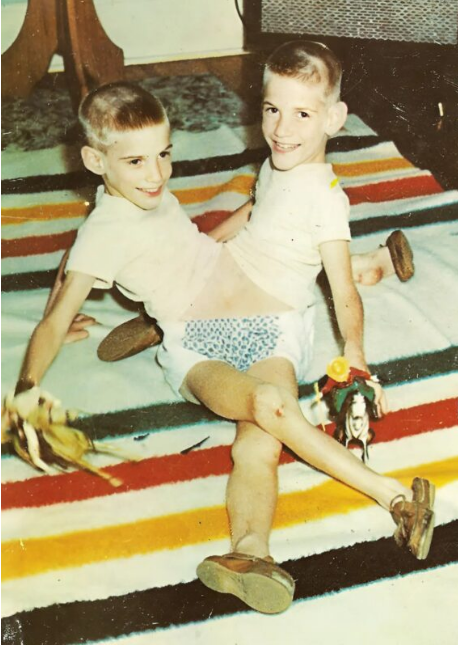
These twin brothers were born joined at the abdomen and pelvis, and from the very first moments of life, they attracted both astonishment and concern. Doctors quickly realized that their condition was far more complex than most had ever seen. Because they shared vital internal organs, the idea of separating them was ruled out almost immediately. Any surgical attempt would have meant certain death for both boys, and so the decision was made to let them grow together as they were. It was not an easy prognosis for their parents to hear, yet Ronnie and Donnie Galyon defied expectations from the very beginning.

Born on October 28, 1951, in Dayton, Ohio, the boys became a medical sensation of their time. The world of the 1950s was far less accustomed to seeing conjoined twins live past infancy, and yet here were two babies who not only survived but showed an eagerness for life. Their parents had seven other children, and raising such a large family was already a challenge. The situation with Ronnie and Donnie brought additional strain—financial, emotional, and physical. But what the boys lacked in independence, they made up for with resilience and curiosity.
As they grew, it became clear that a “normal” childhood would not be possible. Simple activities like playing on swings or riding bicycles were out of reach. But the Galyon family found ways to adapt, ensuring that the twins still experienced joy and discovery. They learned to walk side by side, developed coordination for small tasks, and most importantly, they nurtured a remarkable sense of humor. They were known to joke about their condition, turning what could have been a source of sadness into laughter.

The reality, however, was that their family struggled financially. Supporting nine children was no small task, and medical bills for the twins only added to the pressure. Their parents faced a difficult decision: to shield the boys from the public eye or to share their story with the world. Eventually, they chose the latter, believing it would provide opportunities that otherwise would not exist. From a young age, Ronnie and Donnie began appearing at traveling fairs and sideshows.
To some, they were marketed as a curiosity, something unusual to be marveled at. Crowds lined up to catch a glimpse of the brothers who shared one lower body. For Ronnie and Donnie, the experience was complicated. On one hand, they enjoyed the travel and the chance to see new places, even visiting other countries. On the other, they were aware that people were staring not out of friendship, but out of fascination with their difference. Yet the income they brought in was significant, and it helped provide for their siblings back home. In that sense, they carried responsibility for the entire family from a very young age.

As the years passed, the twins gradually stepped away from show business. Times were changing, and the popularity of sideshows declined. Instead, they focused on building a quieter life. What they lacked in traditional independence, they found in shared companionship. They loved simple pleasures—watching sports on television, cheering for their favorite teams, going fishing at local lakes, and taking walks through their neighborhood. Though they never married and lived their lives without romantic partners, they were far from lonely. They had friends, siblings, and eventually nieces and nephews who adored them. Their personalities were warm, approachable, and filled with humor.
Those who knew Ronnie and Donnie often remarked on their positivity. Rather than dwelling on what they could not do, they focused on what they could. Their presence was a reminder that joy is possible even in extraordinary circumstances.
Of course, as they grew older, health problems became more pronounced. Their fused bones and shared systems meant their mobility was increasingly limited. Walking became painful, and eventually they required wheelchairs specially designed to accommodate their unique bodies. Despite these challenges, their bond only grew stronger. They had spent every moment of life together, and they faced aging in the same way—side by side.
In their later years, they moved into the home of their younger brother Jim. Along with his wife, Jim provided daily care for the twins, helping them with everything from meals to medical needs. It was a gesture of love and loyalty that allowed Ronnie and Donnie to remain comfortable in a family environment rather than in a hospital or nursing facility.
Their story reached a new level of recognition in 2014, when they were officially acknowledged by the Guinness World Records as the oldest living conjoined twins in the world. At that time, they were 62 years old, and their longevity astonished medical experts. What had once been seen as an impossible prognosis had turned into a record-breaking achievement. For Ronnie and Donnie, the honor was less about fame and more about validation. They had lived not just long lives, but fulfilling ones, in spite of the obstacles.
By the time they reached their late sixties, their health had declined significantly, but their spirits remained high. They continued to enjoy time with family, telling stories, watching television, and reminiscing about their younger years. Visitors often noted the way they teased one another, finishing each other’s sentences and laughing at old jokes. Their closeness was something most siblings could only dream of.
On July 4, 2020, Ronnie and Donnie passed away together at the age of 68. Their death made headlines around the world, not just because of their condition, but because of the extraordinary life they had built together. They had faced challenges most could not imagine, yet they lived with humor, dignity, and resilience.
Their legacy is more than a medical record. It is a story of brotherhood, of family support, and of the human spirit’s ability to adapt and thrive. They never walked down the aisle or had children of their own, but they touched countless lives—those of their siblings, their friends, and the many strangers who learned from their example.
Even now, photos of Ronnie and Donnie at 68 evoke a mix of emotions: sadness at their passing, admiration for their endurance, and respect for the unity they embodied. For all the medical labels and headlines that followed them through life, in the end, they were simply two brothers who lived every day together, proving that happiness is not defined by circumstance but by the love and laughter shared along the way.


